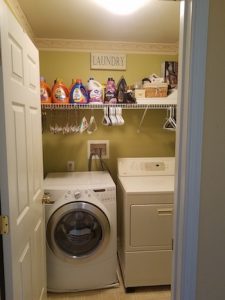My Evernote conversion occurred about five years ago. Stuffed in the back of my junk drawer (yes, I also have one) for several years, lay a handwritten recipe for the best maple balsamic salad dressing obtained from a restaurant in Vermont. Frustrated with my lack of organization for something so valuable, I downloaded Evernote and my life was forever changed.
I created a notebook in the Evernote app and titled it “Recipes,” took a photo of the recipe within the Evernote app et voila! Wherever I am, on my phone, tablet or laptop I have a screenshot of the recipe. I quickly saw how transformational this would be in both my personal and professional life. When a friend recommends a great restaurant, it goes into the notebook I created titled “Recommended Restaurants”. I also do this for movies, books, wine, travel destinations, decorating ideas. All those great details we scribble on the back of napkins never to find again.
If I’m surfing the web, I can use Evernote webclipper to clip an article or page and put it into the notebook of my choice. I can also dictate notes into Evernote and draw using the Skitch app.
I also have a notebook for each of my kids. I have a screenshot of their health insurance cards, health records, photos of their artwork from Kindergarten so I could get rid of those large poster-size monstrosities, er, I mean works of art. The list goes on.
For my business, I’m able to share notebooks with my team and with our clients. We often take notes during an organizing session and share these with our clients. Evernote also eliminates the need to email documents back and forth. Instead, the whole team can collaborate and has access whether they are working remotely or in the office to notes, documents, photos, etc.
I’m barely scratching the surface of Evernote’s endless possibilities. For more information and to create your free online account check out www.evernote.com
 When it comes to washing clothes, it can be a daunting task. I’m a wife, mother, daughter, sister. You name, it, I’m it.
When it comes to washing clothes, it can be a daunting task. I’m a wife, mother, daughter, sister. You name, it, I’m it.
Let me just air my dirty laundry. It takes a lot of work to manage a home. I have a family of three and we have four to five loads of clothes to wash weekly. My son is involved in sports and camp, hubby referees basketball and works out, and I go to the gym on a regular basis.
I used to resent leaving the weekends for washing clothes and cleaning the house. I wanted my weekends for spending time with my family and doing fun stuff! As a professional organizer, I’ve learned to put some systems in place to make life a little easier for my family and me. I hope these tidbits will encourage you to do the same.
Tidbit 1: Decide what day and time of the week you will do laundry put it on your calendar. This is crucial to avoid washing a load every day. An early bird, I prefer washing clothes early Friday mornings.
Tidbit 2: Make sure your laundry room is organized and has all essential items to wash clothes. Decorate the room so it looks inviting. A nice coat of paint will do.
Tidbit 3: Create a chore calendar using a dry erase board.
Tidbit 4: Have each family member have their own laundry basket in their closet.
Tidbit 5: Our laundry rule is: If I find tissues, erasers, pens, money, food, etc. in pockets while I sort clothes, it will cost the wearer 25 cents for each item. I have a digital coin jar that I keep in laundry room, which helps pay for detergent. It’s amazing how well this pay-up system works!
Tidbit 6: Keep the laundry room clean at all times. Nothing is more discouraging than going to a messy laundry room. Designate a place for all items. Take a photo of the laundry room to remind the family that this is the way room stays.
I hope these tidbits were helpful!
 By now you’re familiar with Re-cycling, but have you heard of Pre-cycling? What about Up-cycling? What follows are descriptions of these “cycling” processes. Applying them to your routines will reduce the amount of packaging and other items that end up in landfills.
By now you’re familiar with Re-cycling, but have you heard of Pre-cycling? What about Up-cycling? What follows are descriptions of these “cycling” processes. Applying them to your routines will reduce the amount of packaging and other items that end up in landfills.
PRE-CYCLING
Pre-cycling is basically preventing recycling. It’s the practice of avoiding and reducing consumer waste by buying unpackaged, reusable or recyclable products.
Examples:
RE-CYCLING
It’s great to recycle through your municipality but you (hopefully!) may want to go farther.
Examples:
UP–CYCLING
Up-cycling is the creative reuse of materials to produce a higher quality item.
Examples:
Check out Pinterest for tons of other up-cycling ideas. Please post some of your up-cycled projects as we’d love to see them.
I hope I’ve expanded your awareness of options available to prevent unnecessary trash and recycling. Why not be creative and up-cycle some holiday gifts?
Work toward keeping your ecological footprint as small as possible!
 Is the morning of the first day of school a frenetic, crazy time at your house? How about the next few days? Whether your child is elementary- or high-school bound, it’s hard to get her up and moving in the morning and to bed at a reasonable time. Once she’s awake, then comes figuring out what to wear, a frantic search for the missing shoe because another pair isn’t acceptable, followed by general chaos that causes wasted time, drama and stress!
Is the morning of the first day of school a frenetic, crazy time at your house? How about the next few days? Whether your child is elementary- or high-school bound, it’s hard to get her up and moving in the morning and to bed at a reasonable time. Once she’s awake, then comes figuring out what to wear, a frantic search for the missing shoe because another pair isn’t acceptable, followed by general chaos that causes wasted time, drama and stress!
It doesn’t have to be this way. With some simple planning and organization, things can run smoothly. Whether your child is starting school for the first time or a returning student, these tips will ease the transition from summer to school.
Being organized makes life so much easier. As one of my favorite clients said upon completing his project, “Peace through organization.”
 Have you ever heard of BOGO? What about FOMO or YOLO?
Have you ever heard of BOGO? What about FOMO or YOLO?
These acronyms are clever and catchy:
BOGO: Buy One, Get One is an advertising phrase that encourages people to purchase because of the promise of a second item…whether they need it or not.
FOMO: Fear Of Missing Out is a phenomenon where people refuse to commit to plans or feel less present in their current activity because they wonder what they’re missing (that might be more fun).
YOLO: You Only Live Once is my youngest daughter’s favorite.
Ever heard of AUG? Don’t worry if you haven’t. Other than being the abbreviated version for this month, it is my attempt to be clever by encouraging de-cluttering throughout August. AUG stands for Anything Unused Goes!
AUG is an acronym that is very flexible. I invite you to get creative with the different ways you can use it to clear unused, useless and unworthy things from your life, space and storage areas.
How do you decide worth or usefulness? Please don’t decide worth solely by how much you spent or invested in something. Real worth is defined by how valuable it is to you today. Decide how necessary your stuff is to your life and its worth of the space it’s taking up in your home, car or office.
Lots of folks confuse usefulness with an item’s ability to still be useful – without considering if that item is of actual use to them. Today, there are so many ways to donate, repurpose and recycle things. Don’t hold onto things that clutter YOUR life. Let Anything Unused Go!
 Sometimes the simplest things make a huge difference. We spend a lot of time on computers, and if we could do what we needed to do faster, there would be more time to do the things we want to do. Here are my top Google short-cuts that help me save time.
Sometimes the simplest things make a huge difference. We spend a lot of time on computers, and if we could do what we needed to do faster, there would be more time to do the things we want to do. Here are my top Google short-cuts that help me save time.
1. Google is a great spell check
Don’t know how to spell a word? Type in the word using your closest guess. As long as your guess is reasonably close, Google returns the correct spelling.
2. Google searches on images
When looking for a product, type in the product description and select “images” for your search tool (gray options across the top.)
3. Google is a dictionary
Need a definition? You don’t need to go to a dictionary website. Type in “define” and the word and google give the definition.
4. Google understands date ranges
To identify a range of years, use two periods. I use it often to get the most current technology results. (iPhone updates 2016..2017)
5. Google is a calculator
Type in an equation and Google gives you the result and displays a calculator for additional calculations.
6. Google gives the weather forecast
Type in the zip code and the word weather and you get a 10-day forecast. (weather 08003)
7. Google answers questions
Type in the question and results yield the answer. (When does daylight savings time end?)
8. And my personal FAVORITE – Google is a fabulous timer
Let your computer alert you after a certain amount of time? Type in “timer” and the length of time, and a countdown timer dings when you are out of time. (Timer 10 minutes)